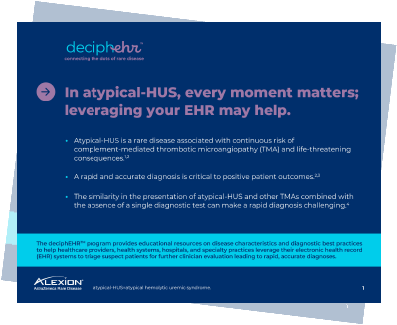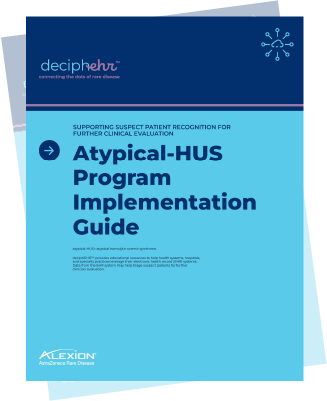In atypical-HUS, every moment matters.
- Atypical-HUS is a rare disease associated with continuous risk of complement-mediated TMA and life-threatening consequences1,2
- A rapid and accurate diagnosis is critical to potentially optimize patient outcomes2,3
- The similarity in the presentation of atypical-HUS and other TMAs combined with the absence of a single diagnostic test can make a rapid diagnosis challenging4
Take action with an atypical-HUS toolkit.
Leveraging EHRs may help health organizations triage patients for further evaluation5
Why is early atypical-HUS patient recognition important?

Atypical-HUS is a serious condition that can quickly lead to ESRD and death in adult and pediatric patients.6*

7 days is the maximum suggested time to improve the atypical-HUS diagnostic and management process.7

Patients with atypical-HUS may be mistreated with plasma therapy. Atypical-HUS patients have poor long-term outcomes to plasma-based therapy despite transient normalization of hematologic parameters.3,8,9
EHR=electronic health record; TMA=thrombotic microangiopathy; ESRD=end-stage renal disease.
*Based on a study of 214 atypical-HUS patients who received care in France, excluding all cases of secondary atypical-HUS except pregnancy. 89 of the patients were categorized as children (<16 years old) and 125 as adults (≥16 years old).
References: 1. Schaefer F, Ardissino G, Ariceta G, et al. Clinical and genetic predictors of atypical hemolytic uremic syndrome phenotype and outcome. Kidney Int. 2018;94:408-418. 2. Azoulay E, Knoebl P, Garnacho-Montero J, et al. Expert statements on the standard of care in critically ill adult patients with atypical hemolytic uremic syndrome. Chest. 2017;152(2):424-434. 3. Laurence J, Haller H, Mannucci PM, Nangaku M, Praga M, Rodriguez de Cordoba S. Atypical hemolytic uremic syndrome (aHUS): essential aspects of an accurate diagnosis. Clin Adv Hematol Oncol. 2016;14(11)(suppl 11):2-15. 4. Sakari Jokiranta T, Viklicky O, Al Shorafa S, et al. Differential diagnosis of thrombotic microangiopathy in nephrology. BMC Nephrol. 2017;18:324. 5. Ben-Assuli O, Sagi D, Leshno M, Ironi A, Ziv A. Improving diagnostic accuracy using EHR in emergency departments: a simulation-based study. J Biomed Inform. 2015;55:31-40. 6. Fremeaux-Bacchi V, Fakhouri F, Garnier A, et al. Genetics and outcome of atypical hemolytic uremic syndrome: a nationwide French series comparing children and adults. Clin J Am Soc Nephrol. 2013;8(4):554-562.7. Ryan M, Donato BMK, Irish W, Gasteyger C, L'Italien G, Laurence J. Economic impact of early-in-hospital diagnosis and initiation of eculizumab in atypical haemolytic uraemic syndrome. Pharmacoeconomics. 2020;38(3):307-313. 8. Pishko AM, Arepally GM. Predicting the temporal course of laboratory abnormality resolution in patients with thrombotic microangiopathy. Blood. 2014;124(21):4192. 9. Padmanabhan A, Connelly-Smith L, Aqui N, et al. Guidelines on the use of therapeutic apheresis in clinical practice – evidence-based approach from the writing committee of the American Society for Apheresis: the eighth special issue. J Clin Apher. 2019;34(3):171-354.




